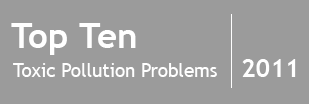Tannery Operations
Chromium Pollution
Estimated Population at Risk:
1.8 Million
Description
Around the world, the vast majority of the tannery industry run their operations with good pollution controls, and does not expose local populations to health risk. The large shoe manufacturers carefully screen to make sure their suppliers have well-run facilities. Certainly, there is no health risk to wearing the leather products made by tanners. However, one can find many sites throughout the developing world with abandoned factories that used to make tanning chemicals, or poorly-run (usually small) tanneries, or legacy contaminated waterways with dangerous levels of chemicals. These places pose significant public health risks to local populations.
The leather manufacturing industry consists of several different processes, with one of the most important activities being the tanning of the raw hides. Tanning involves the processing of raw leather in order to make it more resilient and strong for use in a variety of different products. Tanning is a widespread, global industry that works with both light and heavy types of leather. Light leather is generally used for shoes and other soft products such as purses, and heavy leather is used for straps, belts, and in various machinery.
The tanning process itself is made up of three general phases: acquisition and pretreatment of raw animal hides; treatment of the hides with a tanning agent; and drying and shining the hides before sending them to product manufacturers. Though these steps illustrate the general process, there are often many different processes that can be carried out at tanning facilities, and each may provide a variety of other services, such as bleaching, dyeing, finishing, and weaving of the hides.35
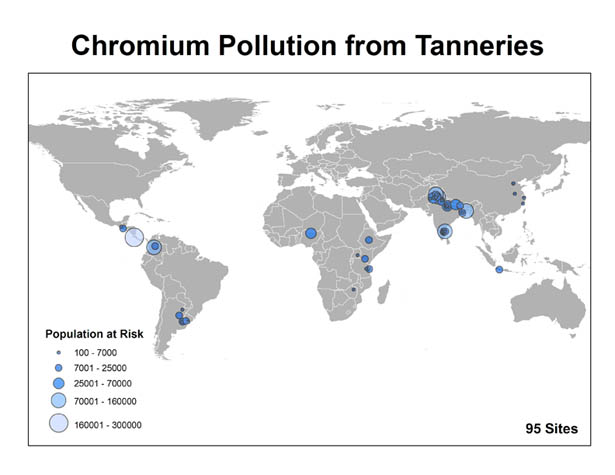
Populations estimates are preliminary and based on an ongoing global assessment of known polluted sites.
Industrial Process
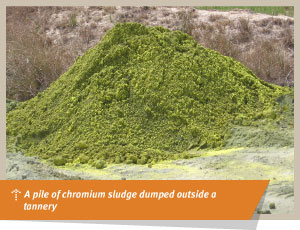 The two main types of tanning are chrome tanning and vegetable tanning, with chrome tanning making up a large majority of the industry. Chromium compounds are applied to protect hides from decay and to make them more durable against moisture and aging.36 Chromium interacts with fibers in the raw hide during a bathing process, after which the tanned hides are wrung and prepared for finishing.37 Other materials that may also be used in the pretreatment and tanning processes include sulfuric acid, sodium chlorate, limestone, and limestone soda ash.
The two main types of tanning are chrome tanning and vegetable tanning, with chrome tanning making up a large majority of the industry. Chromium compounds are applied to protect hides from decay and to make them more durable against moisture and aging.36 Chromium interacts with fibers in the raw hide during a bathing process, after which the tanned hides are wrung and prepared for finishing.37 Other materials that may also be used in the pretreatment and tanning processes include sulfuric acid, sodium chlorate, limestone, and limestone soda ash.
Due to the repeated processes of soaking raw hides and wringing them out, the tanning process creates large amounts of wastewater that may be contaminated with many different chemicals. Because there is wide variety in the chemicals used during the tanning process, wastewater from this industry can have very different chemical makeups. However, chromium contamination and high chemical oxygen demand are typical problems associated with tannery effluents, both of which can pose serious risks to the environment and human health. 38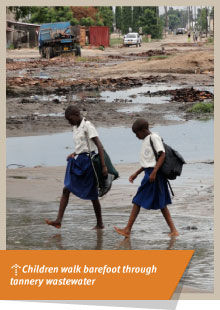
In addition to creating potentially toxic wastewater, some tanneries also produce large amounts of solid waste that contain chromium, including: hide scraps, skins, and excess fats. Toxins from this waste can leach into nearby soil and water, placing nearby residents at risk of contamination.
Global Context
A large portion of the world’s tanning industry operates in low- and middle-income countries, and the percentage of these countries contributing to light and heavy leather materials increased from 35% to 56% and 26% to 56%, respectively, between 1970 and 1995.39 Many of these tannery sites are clustered together, creating heavily polluting industrial areas in many countries. In Hazaribagh, for example—a particularly large tanning region of Bangladesh that has over 200 separate tanneries—it is estimated that 7.7 million liters of wastewater and 88 million tons of solid waste are disposed of on a annually. These pollutants are responsible for the contamination of all nearby surface and groundwater systems with severely high levels of chromium.40

According to the information collected in Blacksmith’s inventory of sites, South Asia, and in particular India and Pakistan, has the highest number of tanning industries, with South America also at risk of large populations being exposed to chromium contamination.
Exposure Pathways
Chromium from leather tanning can make its way into air, soil, food, and water, and the most common forms of exposure are through inhalation of dust or fumes and ingestion of or contact with contaminated water. Workers in tanning facilities can inhale airborne chromium and can also be exposed by dermal contact from improper handling.
Wastewater and solid waste from tanning operations often find their way into surface water, where toxins are carried downstream and contaminate water used for bathing, cooking, swimming, and irrigation. Chromium waste can also seep into the soil and contaminate groundwater systems that provide drinking water for nearby communities. In addition, contamination in water can build up in aquatic animals, which are a common source of food.
Soil that is contaminated by chromium waste also poses a health hazard, since toxic dust can be inhaled by both people and livestock.41
Health Effects
Chromium commonly occurs in two forms. Trivalent chromium (chromium III) is a naturally occurring element that is relatively stable and innocuous, and can be found in plants, animals, and soil. Hexavalent chromium (chromium VI) is far more dangerous for humans, and is usually created by anthropogenic causes.
Hexavalent chromium is a toxic human carcinogen that can cause or increase the rates of certain cancers. Inhalation of chromium VI, which occurs most frequently among workers, has been found to cause cancer of the respiratory system. Inhalation of dust contaminated with chromium can also lead to eye damage, ulcerations, swelling, asthmatic bronchitis, and irritation to the throat and nose. More chronic exposure can sometimes cause sores to develop in the nose and can even lead to the formation of holes in the nasal septum.42
Ingestion of chromium VI can cause stomach problems, such as ulcers, and can also be damaging for kidney and liver functions. Dermal contact causes a number of skin problems, including rashes, sores, and ulcers.
In addition, several studies have found evidence that chromium accumulation in the body can damage a person’s ability to metabolize iron, which can lead to iron deficiency anemia.
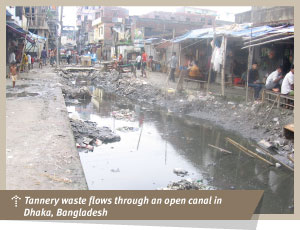 What is Being Done
What is Being Done
Blacksmith Institute has successfully implemented programs to help clean up and alleviate the impacts of chromium on human health and has found several cost-effective and efficient ways to help address the problem. Because trivalent chromium is far less toxic than chromium VI, water that is contaminated with chromium VI can be treated with an electron donor that converts the pollutant to its less damaging, trivalent state. Other studies have found that bone charcoal, which is produced by burning animal bones, has the ability to remove chromium from water.43
When soil and solid waste are contaminated with chromium, these materials can be effectively removed and disposed of in order to prevent further human contact with toxins. Other methods of removing chromium contamination from soil include vermiculture, which involves the use of worms to concentrate heavy metals. In addition, more recent studies have found that some forms of salt-tolerant bacteria may be able to decrease chromium contamination in soil.44
Blacksmith Institute, in partnership with the Central Pollution Control Board of Kanpur, India, recently conducted a program that helped to reduce groundwater contamination caused by over 300 tanneries in the area. Tests conducted after the treatment showed that hexavalent chromium levels had become undetectable in some of the wells. Additionally, a program in collaboration with local officials and NGOs in Gujarat, India, was able to move 60,000 tons of waste sludge from a tannery operation to a secure location. The remaining soil in the area was treated using vermiculture.
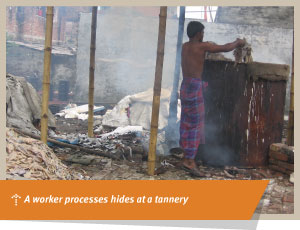 Example – DALY Calculations
Example – DALY Calculations
A town in northern India on the banks of the Ganges River has approximately 400 small tannery operations that are contaminating the area with large amounts of hexavalent chromium. Because many of these tanneries are informal, they do not have proper waste treatment facilities, and effluent is openly dumped into the surrounding environment. Contaminated water from the river is used for a variety of purposes, particularly for irrigation. Soil in the area is also very contaminated with hexavalent chromium, which poses a dangerous health risk if dust from dry areas is inhaled. Blacksmith estimates that approximately 60,000 people are at risk of developing health problems from exposure to the toxic pollution. Samples in the area found 6,227.8 parts per million of hexavalent chromium in the soil.
DALYs associated with health issues from hexavalent chromium exposure are estimated to be 167,066 for an exposed population of 60,000 people. Thus, the 60,000 affected people will have a collective 167,066 years lost to death, or impacted by disease or disability. This comes out to 2.8 years lost or lived with a disability per person.
Footnotes:
[35]: Correia, V.M., T. Stephenson and S.J. Judd. “Characterisation of Textile Wastewaters – A Review.” Environmental Technology, Vol. 15, No. 10 (1994): 917-929.
[36]: Leather Tanning.” U.S. Environmental Protection Agency, 1997. Available at: http://www.epa.gov/ttnchie1/ap42/ch09/final/c9s15.pdf.
[37]: Leather Tanning.” U.S. Environmental Protection Agency, 1997. Available at: http://www.epa.gov/ttnchie1/ap42/ch09/final/c9s15.pdf.
[38]: Song, Z., C.J. Williams and R.G.J. Edyvean. “Sedimentation of Tannery Wastewater.” Water Research, Vol. 34, No. 7 (2000): 2171-2176.
[39]: Jenkins, R., J. Barton and J. Hesselberg. “7. The Global Tanning Industry: a Commodity Chain Approach.” Environmental Regulation in the New Global Economy: The impact on industry and competitiveness. Edward Elgar Publishing, 2004. 157-172.
[40]: Bhuiyan, M.A.H., et al. “Investigation of the Possible Sources of Heavy Metal Contamination in Lagoon and Canal Water in the Tannery Industrial Area in Dhaka, Bangladesh.” Environmental Monitoring and Assessment, Vol. 175, No. 1-4 (2010): 633-649.
[41]: Möller, A., H. W. Mu?ller, A. Abdullah, G. Abdelgawad, and J. Utermann. “Urban Soil Pollution in Damascus, Syria: Concentrations and Patterns of Heavy Metals in the Soils of the Damascus Ghouta.” Geoderma, Vol. 124, No. 1-2 (2005): 63-71.
[42]: Health Effects of Hexavalent Chromium.” OSHA Factsheet. Occupational Safety and Health Administration. U.S. Department of Labor. July 2006. Available at: http://www.osha.gov/OshDoc/data_General_Facts/hexavalent_chromium.pdf
[43]: Dahbi, S., et al. “Removal of Trivalent Chromium from Tannery Waste Waters Using Bone Charcoal.” Analytical and Bioanalytical Chemistry, Vol. 374, No. 3 (2002): 540-546.
[44]: Megharaj, M., S. Avudainayagam, and R. Naidu. “Toxicity of Hexavalent Chromium and Its Reduction by Bacteria Isolated from Soil Contaminated with Tannery Waste.” Current Microbiology, Vol. 47, No. 1 (2002): 51-54.

-
Artisanal Gold Mining
Mercury Pollution
-
Industrial Estates
Lead Pollution
-
Agricultural Production
Pesticide Pollution
-
Lead Smelting
Lead Pollution
-
Tannery Operations
Chromium Pollution
-
Mining and Ore Processing
Mercury Pollution
-
Mining and Ore Processing
Lead Pollution
-
Lead-Acid Battery Recycling
Lead Pollution
-
Arsenic in Groundwater
Arsenic Pollution
-
Pesticide Manufacturing and Storage
Pesticide Pollution
-
The Rest of the Toxic Twenty

